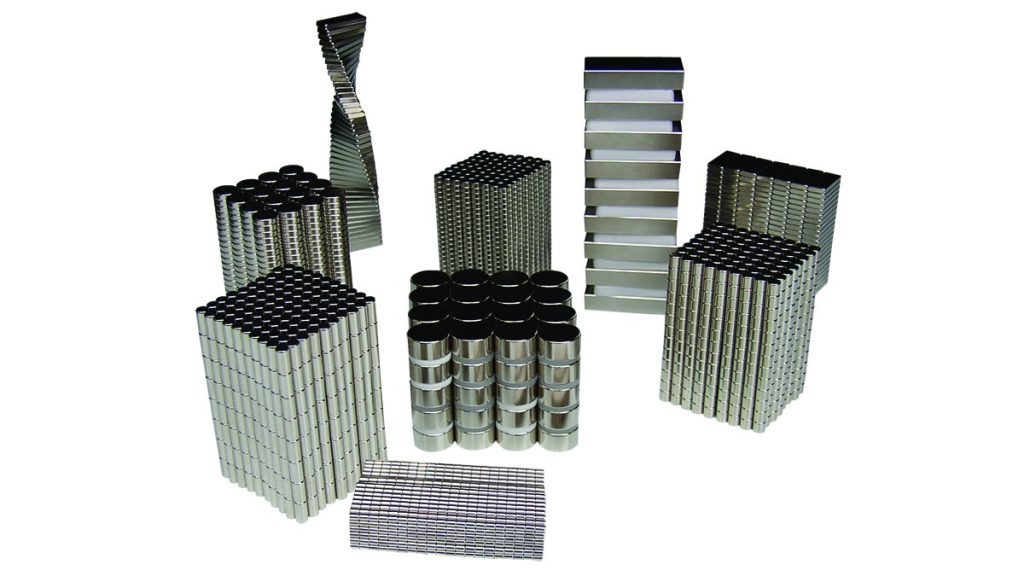Renowned for their superior strength, neodymium magnets currently stand as the strongest commercially accessible magnets, capable of lifting objects far exceeding their own weight.
Despite their small size, these magnets contribute significantly to modern technology, underlining their crucial role in powering countless everyday devices and innovations. From computers and medical devices to motors, speakers, and aerospace technology, their versatility is unmatched.
Understanding the nuances of neodymium magnets will ensure you purchase the correct magnet for the job. Take a look at all you need to know about these small but powerful products.
Neodymium magnets and their uses in industry
Neodymium magnets, derived from rare-earth elements, stand out in the industrial landscape for their unmatched magnetic strength. Also referred to as neo magnets, neodymium iron boron magnets, or NdFeB magnets, these magnets are also incredibly compact, making them both exceptionally useful and versatile.
From powering electric motors and generators in the automotive and aerospace sectors to enhancing the performance of speakers and headphones, neodymium magnets play a vital role. Their compact size and incredible magnetic properties also make them indispensable in the manufacturing of electronics, medical devices and renewable energy systems.
Their versatility and robust magnetic strength make them a cornerstone of modern industrial processes, continually pushing the boundaries of innovation and technological advancement.
What do you need to consider when buying neodymium magnets?
Buying neodymium magnets can be somewhat of a challenge due to the multitude of grades, shapes, sizes and uses these magnets can have. To help you find exactly what you need for the job, below are several key considerations to keep in mind before making the purchase.
What do you need them for?
First and foremost, you need to understand the intended use of your neodymium magnet. This will then inform you of the size, shape, grade, temperature and pull force needed from your magnet.
For example, in motors, the magnet must provide adequate force, while in delicate electronic devices, a smaller, less powerful magnet may suffice. Similarly, in speaker design, choosing the appropriate magnet size and strength may directly impact the sound quality if you incorrectly choose the wrong magnetic grade.
In aerospace applications, where components are subjected to demanding environmental conditions, choosing the appropriate magnet coating is also crucial. These coatings must maintain the magnets structural integrity and magnetic properties over time, contributing to the reliability and longevity of sensors, actuators, or navigation equipment.
While these are just a few examples of why you must understand the intended use, failing to align the neodymium magnet with its intended application will lead to inefficient performance or premature demagnetisation.
What size and shape do you need?
The size and shape of your magnet is a crucial consideration, and it may be obvious depending on what the magnet will be used for. That said, in general, smaller magnets tend to be weaker, yet they offer increased versatility and ease of use in specific applications.
On the other hand, larger magnets are stronger and more suitable for heavy-duty tasks, but they may come with a higher cost.
In terms of shape, neodymium magnets are available in a wide variety of
shapes, such as bars, rings, discs, horseshoes, cubes and rectangles. As such, the chosen shape will directly influence the magnet’s utility. For instance, a disc magnet may be suitable for mechanical projects, while horseshoe magnets are very effective in holding objects.

Will your magnets be exposed to high temperatures?
You should also consider the temperature at which the magnet will operate, as different magnets exhibit varying responses to temperature changes. In fact, some magnets may lose strength or become permanently demagnetised at high temperatures.
For instance, standard-grade neodymium magnets should not exceed 80 degrees Celsius during operation, as they experience irreversible performance losses beyond this point. However, you can buy high-temperature grades of neodymium magnets that can withstand much higher temperatures.
Samarium cobalt magnets, while not as strong as neodymium magnets at room temperature, also have a superior temperature coefficient for both remanence (Br) and resistance to demagnetisation (Hci).
Among permanent magnets, alnico magnets boast the highest maximum operating temperature within the magnet family, maintaining performance until temperatures reach 525°C.
Finally, ferrite magnets, unique in their behaviour, offer increased resistance to demagnetisation with rising temperatures. However, their strength decreases as temperature increases, albeit at a slower rate.
What grade do you need?
Of course, you should make yourself aware of how magnet strength is quantified, as well as how strong you will need your magnet to be.
The magnetic strength of neodymium magnets is denoted in mega Gauss Oersteds (MGOe). A higher MGOe rating corresponds to a more powerful magnet. Neodymium magnets come in various grades, including N35, N40, N45, N50, and N52, with N55 being the strongest.
To select the correct magnetic strength, consider these factors:
- Weight: A magnet with a higher MGOe rating is capable of supporting heavier objects.
- Distance: A magnet with a higher MGOe rating can support an object from a greater distance.
- Size: Generally, a larger magnet has a stronger magnetic field than a smaller one, even if they share the same MGOe rating.
- Cost: Neodymium magnets with a higher MGOe rating tend to be more expensive than those with lower ratings.
What coating do you need?
Neodymium magnets are susceptible to corrosion, so you must use a protective coating to shield them from environmental elements. The most prevalent coatings for neodymium magnets include nickel, zinc and epoxy.
- Nickel: A shiny and malleable metal that is resistant to corrosion and has a high resistance to demagnetisation. However, it is unsuitable for high-temperature settings, as the nickel coating may peel or flake off when exposed to temperatures exceeding 150°C.
- Zinc: A soft and white metal that is corrosion-resistant and has a moderate resistance to demagnetisation. They prove suitable for application in a broad temperature range, though they may not be as durable as nickel-coated magnets.
- Epoxy: A type of plastic that is corrosion resistant and has a high resilience to demagnetisation. It is also suitable for use across a wide temperature spectrum. However, it’s worth noting that they may not match the durability of nickel or zinc coated magnets.
If you are looking to buy a magnet that will operate in damp or corrosive environments, choosing the right coating is also absolutely essential to maintain its strength and performance over time.
What is pull force?
The pull force of a neodymium magnet is a measure of the magnet’s ability to attract and hold ferromagnetic materials. This force is typically measured in pounds (lb) or newtons (N) and represents the maximum force the magnet can exert under ideal conditions.

Before you buy your magnet, you must understand what factors will influence the pull force and, therefore, impact its application:
- Grade of the magnet: Higher-grade magnets generally have stronger magnetic properties and higher pull forces.
- Size and shape: The physical dimensions and shape of the magnet also affect the pull force. Larger magnets and those with specific shapes may have higher pull forces.
- Air gap: The pull force decreases as the distance between the magnet and the object increases.
- Surface conditions: Clean, smooth surfaces allow for better magnetic contact and higher pull forces.
Are Neodymium magnets right for you?
Choosing the right magnet involves considering factors beyond just Neodymium. While neodymium excels in power and versatility, samarium cobalt, another rare earth magnet, boasts high magnetic strength and temperature resistance, making it suitable for specialised applications. That said, due to its unique capacities, samarium cobalt often comes with a higher cost.
Alnico magnets, made up of aluminium, nickel, and cobalt, excel in high-temperature environments and exhibit excellent stability. Alternatively, ferrite magnets, unique for becoming more resistant to demagnetisation as temperatures rise, offer moderate strength. These find effective application in speakers, breaks and clamps, motors and generators, as well as security systems.
Neodymium excels in power but may not suit all scenarios. Considering alternatives like samarium cobalt’s temperature resilience or alnico’s durability helps determine the best fit in terms of specific application needs, environment and budget.
